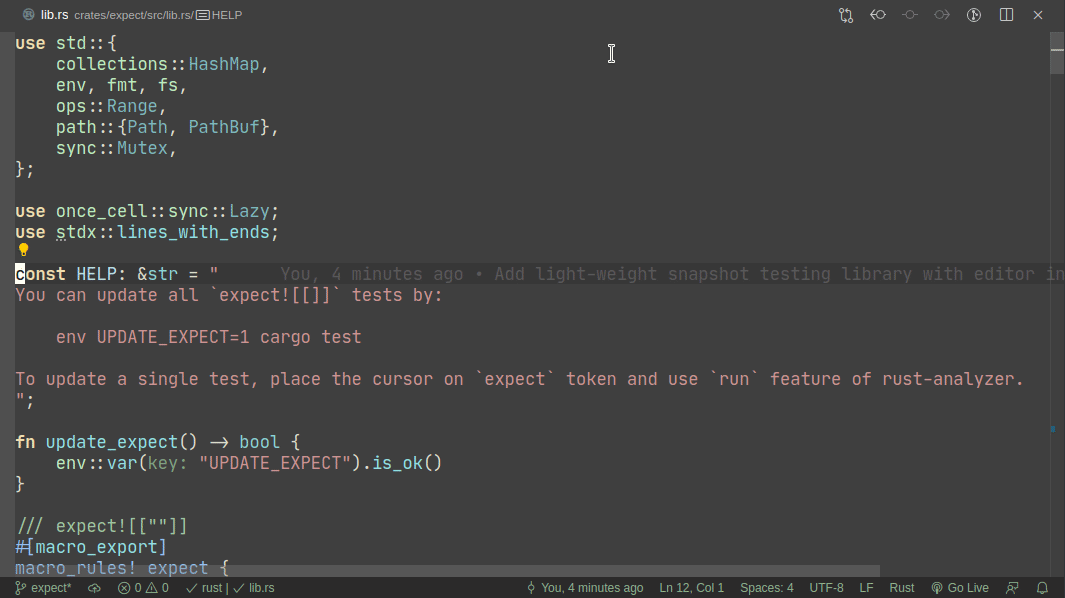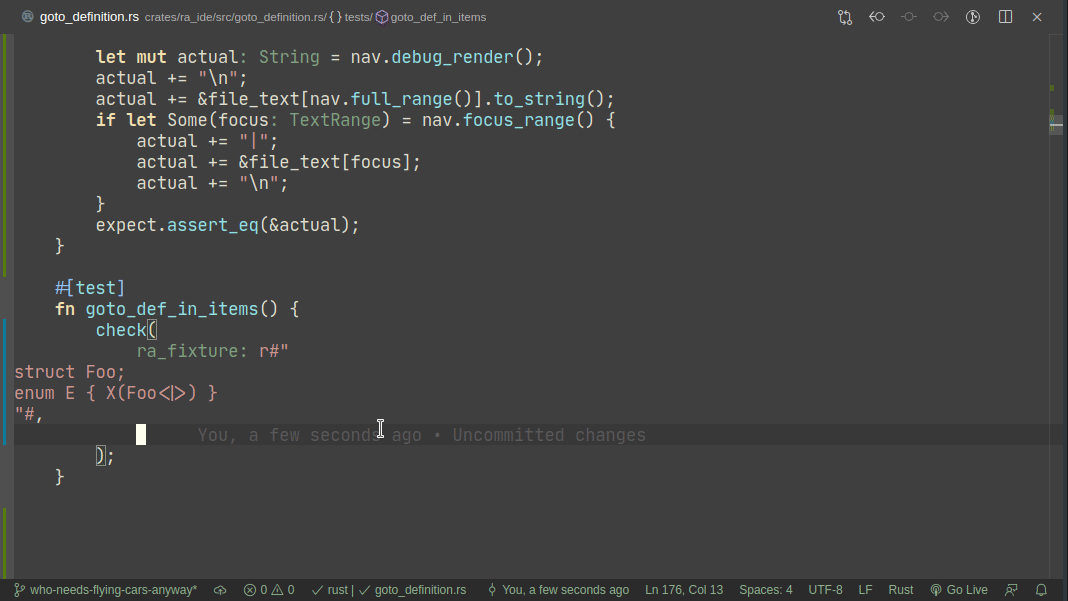This makes the intention of inherent vs. trait impls somewhat more
clear and also fixes (?) an issue where trait impls with an unresolved
trait were added as inherent impls instead (hence the test changes).
5101: Add expect -- a light-weight alternative to insta r=matklad a=matklad
This PR implements a small snapshot-testing library. Snapshot updating is done by setting an env var, or by using editor feature (which runs a test with env-var set).
Here's workflow for updating a failing test:

Here's workflow for adding a new test:

Note that colorized diffs are not implemented in this PR, but should be easy to add (we already use them in test_utils).
Main differences from insta (which is essential for rust-analyzer development, thanks @mitsuhiko!):
* self-updating tests, no need for a separate tool
* fewer features (only inline snapshots, no redactions)
* fewer deps (no yaml, no persistence)
* tighter integration with editor
* first-class snapshot object, which can be used to write test functions (as opposed to testing macros)
* trivial to tweak for rust-analyzer needs, by virtue of being a workspace member.
I think eventually we should converge to a single snapshot testing library, but I am not sure that `expect` is exactly right, so I suggest rolling with both insta and expect for some time (if folks agree that expect might be better in the first place!).
# Editor Integration Implementation
The thing I am most excited about is the ability to update a specific snapshot from the editor. I want this to be available to other snapshot-testing libraries (cc @mitsuhiko, @aaronabramov), so I want to document how this works.
The ideal UI here would be a code action (💡). Unfortunately, it seems like it is impossible to implement without some kind of persistence (if you save test failures into some kind of a database, like insta does, than you can read the database from the editor plugin). Note that it is possible to highlight error by outputing error message in rustc's format. Unfortunately, one can't use the same trick to implement a quick fix.
For this reason, expect makes use of another rust-analyzer feature -- ability to run a single test at the cursor position. This does need some expect-specific code in rust-analyzer unfortunately. Specifically, if rust-analyzer notices that the cursor is on `expect!` macro, it adds a special flag to runnable's JSON. However, given #5017 it is possible to approximate this well-enough without rust-analyzer integration. Specifically, an extension can register a special runner which checks (using regexes) if rust-anlyzer runnable covers text with specific macro invocation and do special magic in that case.
closes#3835
Co-authored-by: Aleksey Kladov <aleksey.kladov@gmail.com>
4940: Add support for marking doctest items as distinct from normal code r=ltentrup a=Nashenas88
This adds `HighlightTag::Generic | HighlightModifier::Injected` as the default highlight for all elements within a doctest. Please feel free to suggest that a new tag be created or a different one used.

Fixes#4929Fixes#4939
Co-authored-by: Paul Daniel Faria <Nashenas88@users.noreply.github.com>
Co-authored-by: Paul Daniel Faria <nashenas88@users.noreply.github.com>
5002: Fix underflow panic when doctests are at top of file r=Nashenas88 a=Nashenas88
While debugging a comment at the top of a test string, I discovered that the offset calculations could underflow and panic. This only seemed to occur in tests, I assume because it's running a debug mode. The wrapping is quickly fixed later on in release mode, which is why this seems to have gone unnoticed. The new checks ensure the value is always positive or zero.
Co-authored-by: Paul Daniel Faria <nashenas88@users.noreply.github.com>
4999: SSR: Allow matching of whole macro calls r=matklad a=davidlattimore
Matching within macro calls is to come later and matching of macro calls within macro calls later still.
Co-authored-by: David Lattimore <dml@google.com>
5000: Remove RelativePathBuf from fixture r=matklad a=matklad
The paths in fixture are not really relative (the default one is
`/main.rs`), so it doesn't make sense to use `RelativePathBuf` here.
bors r+
🤖
Co-authored-by: Aleksey Kladov <aleksey.kladov@gmail.com>
4900: Self variant enum res fix r=BGluth a=BGluth
Fixes#4789.
This is my first PR for this project, so it's probably worth giving it an extra close look.
A few things that I wasn't sure about:
- Is `resolve_path` really the best place to perform this check? It seemed like a natural place, but perhaps there's a better place?
- When handling the new variant `PathResolution::VariantDef`, I couldn't see an obvious variant of `TypeNs` to return in `in_type_ns` for Unions and Structs.
Co-authored-by: BGluth <gluthb@gmail.com>
4921: Allow SSR to match type references, items, paths and patterns r=davidlattimore a=davidlattimore
Part of #3186
Co-authored-by: David Lattimore <dml@google.com>
4851: Add quickfix to add a struct field r=TimoFreiberg a=TimoFreiberg
Related to #4563
I created a quickfix for record literals first because the NoSuchField diagnostic was already there.
To offer that quickfix for FieldExprs with unknown fields I'd need to add a new diagnostic (or create a `NoSuchField` diagnostic for those cases)
I think it'd make sense to make this a snippet completion (to select the generated type), but this would require changing the `Analysis` API and I'd like some feedback before I touch that.
Co-authored-by: Timo Freiberg <timo.freiberg@gmail.com>
4903: Add highlighting support for doc comments r=matklad a=Nashenas88
The language server protocol includes a semantic modifier for documentation. This change exports that modifier for doc comments so users can choose to highlight them differently compared to regular comments.
Example:
<img width="375" alt="Screen Shot 2020-06-16 at 10 34 14 AM" src="https://user-images.githubusercontent.com/1673130/84788271-f6599580-afbc-11ea-96e5-7a0215da620b.png">
CC @woody77
Co-authored-by: Paul Daniel Faria <Nashenas88@users.noreply.github.com>
We might as well handle them internally, via queries.
I am not sure, but it looks like the current LibraryData setup might
even predate salsa? It's not really needed and creates a bunch of
complexity.
4913: Remove debugging code for incremental sync r=matklad a=lnicola
4915: Inspect markdown code fences to determine whether to apply syntax highlighting r=matklad a=ltentrup
Fixes#4904
4916: Warnings as hint or info r=matklad a=GabbeV
Fixes#4229
This PR is my second attempt at providing a solution to the above issue. My last PR(#4721) had to be rolled back(#4862) due to it overriding behavior many users expected. This PR solves a broader problem while trying to minimize surprises for the users.
### Problem description
The underlying problem this PR tries to solve is the mismatch between [Rustc lint levels](https://doc.rust-lang.org/rustc/lints/levels.html) and [LSP diagnostic severity](https://microsoft.github.io/language-server-protocol/specification#diagnostic). Rustc currently doesn't have a lint level less severe than warning forcing the user to disable warnings if they think they get to noisy. LSP however provides two severitys below warning, information and hint. This allows editors like VSCode to provide more fine grained control over how prominently to show different diagnostics.
Info severity shows a blue squiggly underline in code and can be filtered separately from errors and warnings in the problems panel.


Hint severity doesn't show up in the problems panel at all and only show three dots under the affected code or just faded text if the diagnostic also has the unnecessary tag.

### Solution
The solution provided by this PR allows the user to configure lists of of warnings to report as info severity and hint severity respectively. I purposefully only convert warnings and not errors as i believe it's a good idea to have the editor show the same severity as the compiler as much as possible.

### Open questions
#### Discoverability
How do we teach this to new and existing users? Should a section be added to the user manual? If so where and what should it say?
#### Defaults
Other languages such as TypeScript report unused code as hint by default. Should rust-analyzer similarly report some problems as hint/info by default?
Co-authored-by: Laurențiu Nicola <lnicola@dend.ro>
Co-authored-by: Leander Tentrup <leander.tentrup@gmail.com>
Co-authored-by: Gabriel Valfridsson <gabriel.valfridsson@gmail.com>
Anchoring to the SourceRoot wont' work if the path is absolute:
#[path = "/tmp/foo.rs"]
mod foo;
Anchoring to a file will.
However, we *should* anchor, instead of just producing an abs path.
I can imagine a situation where, for example, rust-analyzer processes
crates from different machines (or, for example, from in-memory git
branch), where the same absolute path in different crates might refer
to different files in the end!